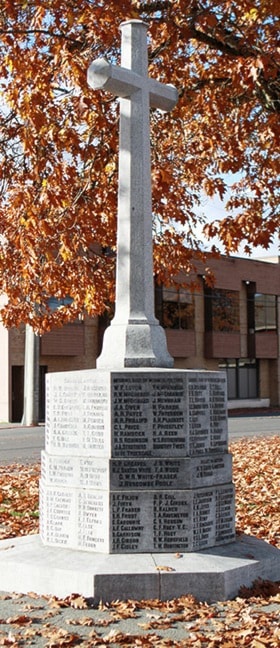It has been said that a soldier only really dies when he’s forgotten.
If I had a loonie for every time someone has said to me, “You must do a lot of research,” why, I’d be, well, maybe not rich, but I’d probably need a wheelbarrow to carry them in. (The loonies, I mean.)
To which I must confess a resounding, yes: every day, all day. Not necessarily thorough research in every case, let’s just say that I do a lot of reconnaissance: in newspapers, books, online, in the field, through interviews — wherever and however information presents itself as possible subject matter for these columns. You can throw in garage sales, too, which double as R&R.
A perfect example is a treasure from a garage sale of probably 20 years or more ago, it’s been that long in my library. But I only read it this week, to find that I’d been sitting on a gold mine all that time.
The book, an expensive hardcover when published by the Bank of Montreal, is Field of Honour: The Second World War, 1945-1946, a tribute to its employees who served in the war. The first half of the book is dedicated to those former employees who didn’t make it home, and it’s here that I struck paydirt.
If you should read through issues of the Cowichan Leader in the 1920s and 1930s, Rev. Bishchlager’s name will appear again and again. My personal interest in him is the fact that his son was killed while serving with the RCAF in the Second World War and his name is on the Duncan Cenotaph. Which is as far as I’ve ever actually researched him even though I’ve been working for several years now on creating profiles of those names on the Cenotaph. But there are a lot of names, from both world wars, and it’s a big job...
So imagine my surprise, and joy, while reading Field of Honour. There, almost at the very beginning (the book is in alphabetical order), this tribute to Sgt. Harold Bischlager, RCAF:
“Born at Duncan, B.C. on August 19th, 1921, he attended Queen Margaret’s School, Duncan Elementary and High Schools, and finally Esquimalt High School, from which he matriculated in 1939. An outstanding student and athlete, he served as president of the Students’ Council and played rugby, soccer, softball, badminton and lacrosse, attaining particular prominence in the latter sport.
“He was also active in Cubs and Boys Scouts, being a Troop Leader in the Duncan troop. On entering the bank in July, 1939, he was attached to Victoria branch, from where he enlisted in the Royal Canadian Air Force in October, 1940. He received his first training at Eburne, B.C., and in July, 1941, graduated as a Pilot from No. 4 Service Flying Training School at Saskatoon, Sask. He then went overseas, where he was attached to No. 220 Training Unit at Wellesbourne in Warwickshire. On completion of the course with that unit he was posted to 87 Squadron at Coningsby, with whom, on December 18th, 1941, he took part in a raid on the German battleships Scharnhorst and Gneisenau, then lying at Brest.
“In the ensuing action the landing gear of his aircraft was put out of commission, and as a result, when attempting to land, he crashed and was instantly killed.”
To be more specific, Sgt. Bischlager and his fellow crewmen were returning to base in Manchester bomber L7490 after it was hit by flak that severely wounded pilot F/Lt. Wright. According to the record, “The flak damage is believed to have been a contributory factor.”
That’s a pretty short bio for a pretty short lifespan but it’s more than we now know about many, indeed most, of those names on the Cenotaph. This, to my mind, is the greatest tragedy of war. It has been said that a soldier only really dies when he’s forgotten. And forgotten, I’m sorry to say, is the case for most of those hundreds of names on the Cenotaph. There’s no one left from the First World War now and veterans of the Second World War are in their late 80s. Short of family and friends, many of them of similar age, who will soon be left to recall them, not just as names on war memorials and in sparse military records, but as flesh-and-blood human beings?
As very young men and women, they offered up their lives for their country — our country. The very least that we can do is to remember them. And I don’t just mean wearing a poppy in November. The starting point for this remembrance is within the family, with those old photo albums and medals and other such memorabilia that should be passed down and treasured and made known to each succeeding generation.
And if grandfather or grandmother is still around, talk to them. With today’s technology you can tape record, even videograph them if they’re so inclined. Think what these memories, saved for posterity, can mean to future generations of your family.
www.twpaterson.com
